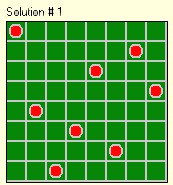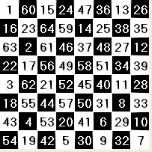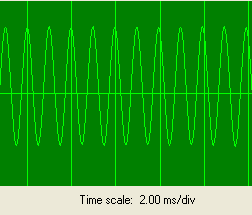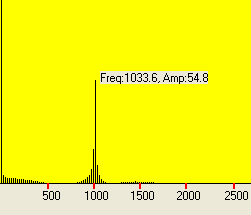What's New - December 2004
[Home]
December 27, 2004:
 While
answering a viewer's question recently, I had a chance to review
the original Eight Queens
Plus code posted here 3 years ago and realized that the
traditional version of the puzzle was not included. I
modified the 3 versions today to allow users to select whether or
not a queen can sit on a diagonal. So the Plus 3 version
will now display not only two unique solutions for the
"Plus" puzzle but also the 12 unique solutions for the
traditional version of the puzzle. Each solution has 7
additional variations (rotations and mirrors) which are also
displayed. How does 8 versions of 12 unique solutions
square with the 92 solutions found by Eight Queens Wirth and
others? It turns out that solution #8 is unchanged after 180
degree rotation, so there are only 4 unique versions of this
solution, reducing the total potentially unique solutions from 96
to 92. Hooray!
While
answering a viewer's question recently, I had a chance to review
the original Eight Queens
Plus code posted here 3 years ago and realized that the
traditional version of the puzzle was not included. I
modified the 3 versions today to allow users to select whether or
not a queen can sit on a diagonal. So the Plus 3 version
will now display not only two unique solutions for the
"Plus" puzzle but also the 12 unique solutions for the
traditional version of the puzzle. Each solution has 7
additional variations (rotations and mirrors) which are also
displayed. How does 8 versions of 12 unique solutions
square with the 92 solutions found by Eight Queens Wirth and
others? It turns out that solution #8 is unchanged after 180
degree rotation, so there are only 4 unique versions of this
solution, reducing the total potentially unique solutions from 96
to 92. Hooray!
December 20, 2004: I appreciate the patience of those subscribers who were inundated with 16 copies of last week's newsletter. I ended up with more new subscribes than unsubscribes and most all the emails responses were of the tone : "I really like your site, but did you know I have received X copies of the newsletter?" I'll fill you in with the rest of the story when I track it down.
I noticed in today's "Top 25 Downloads" report than there were 82 downloads last week of the DFF Play CD, a "best-of" compilation of programs. I've been meaning to update it since there are a number of programs that have been revised and a few new ones that belong there. I promise to do the update right after the new year, so consider holding off downloading until then, especially if you have a slower dial-up connection.
December 16, 2004 1:15PM EST: DFF Newsletter #38 was sent last night and it appears that the mail list server is in a loop! I, and probably most of you 600+ subscribers, have received multiple copies, maybe a dozen so far . I pay the host site, M6.net, $10 a month to host delphiforfun.org so I guess you get what you pay for.
I apologize for the inconvenience this may be causing. I have submitted two "critical" support requests to M6 with no response so far and it appears that there is no other way to contact them. It is now 1:15 PM Eastern Standard time here and I just deleted the entire subscriber list for the newsletter. I hope that stops it. Again I apologize - it ticks me off too.
Gary
 December
12, 2004: The is something going on in the knight's tour
puzzle world that I don't quite understand (which is OK with
me!). A few months ago I developed code to solve the
puzzle with constraints (certain moves occurring in specific
squares). The other day someone requested the ability to
continue searching for solutions after the first solution is
found. The change was simple, so I did it. A revised
Knight's'
Tour with the multiple solutions feature was posted
today.
December
12, 2004: The is something going on in the knight's tour
puzzle world that I don't quite understand (which is OK with
me!). A few months ago I developed code to solve the
puzzle with constraints (certain moves occurring in specific
squares). The other day someone requested the ability to
continue searching for solutions after the first solution is
found. The change was simple, so I did it. A revised
Knight's'
Tour with the multiple solutions feature was posted
today.
December 9, 2004: I implemented some code in the Oscilloscope program the other day which uses Delphi's MouseEnter and MouseLeave messages to turn the label on and off in the spectrum bar graph. Our Delphi Techniques section now has a Mouse enter, Mouse leave Demo program which discusses and illustrates what I learned about processing these messages.
December 5, 2004:


The year is fast winding down, but here is one more interesting exercise. Version 3 of our Oscilloscope program has been posted and now includes a simplified spectrum analyzer! An old friend of mine (Jim Corley, website ) has tackled a violin tune-up project. Besides being an artist, sculptor, and woodworker, Jim is a retired vibration engineer, so naturally he wanted a way to measure resonant frequencies when he administered the "thump test" to his violin. He already has the frequency response charts for the Stradivarius, so now duplicating it the Strad should be a snap!
I also added time scale lines to the oscilloscope display, the ability for users to control the sampling rate, and to save captured data frames in both the time and frequency domains. The Oscilloscope program uses your PC's soundcard to convert sounds to numbers. The screen shots above show a 1,000 Hz (cycles per second) sine wave test generated using our Sound Generator program. Lot's of fun!
